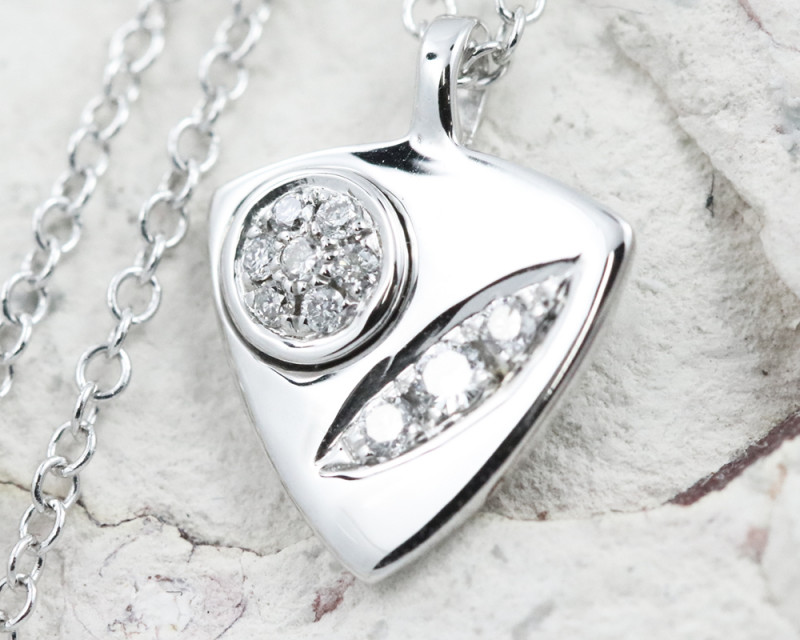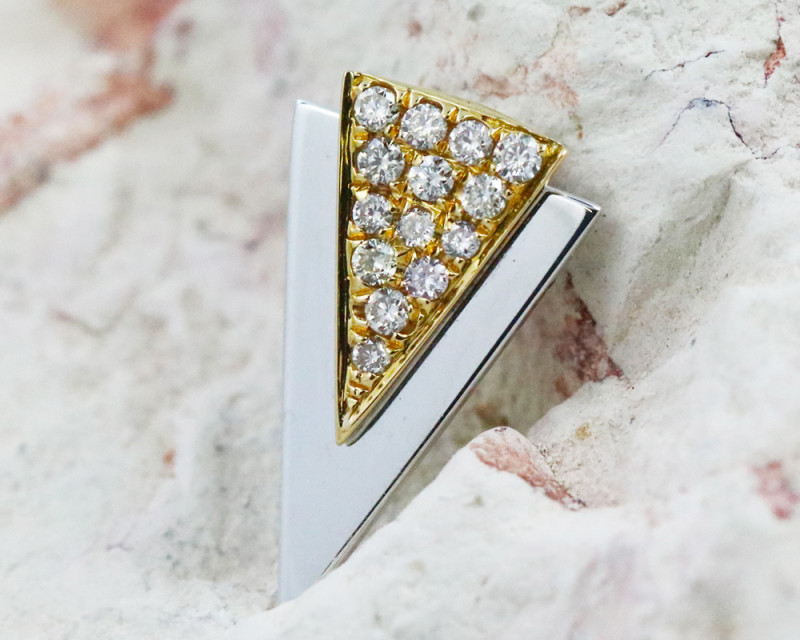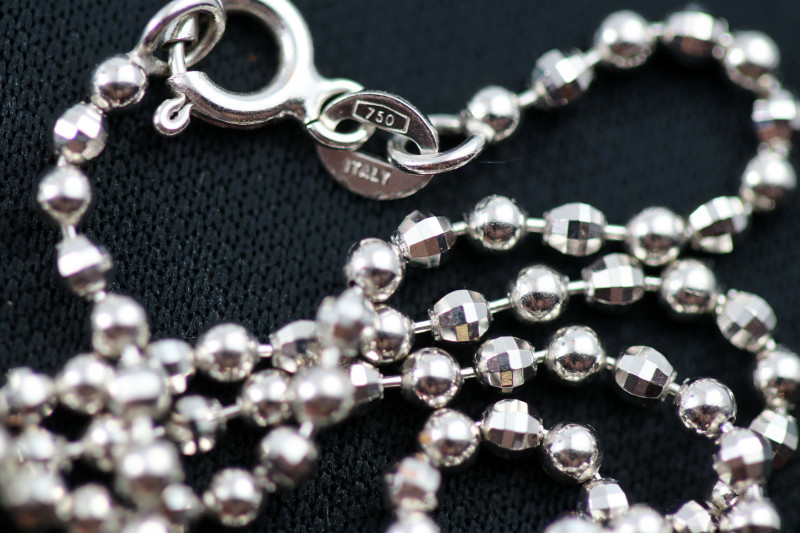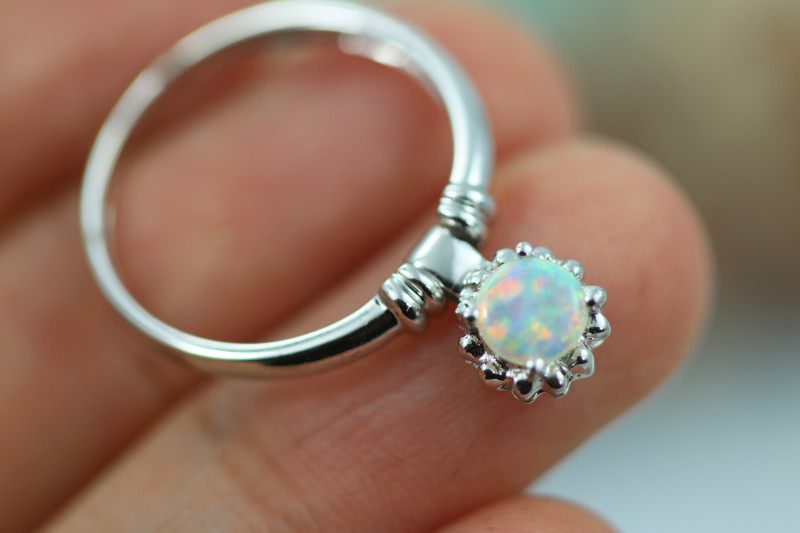
Witgouden sieraden: het metaal en zijn populariteit begrijpen
 Bent u op zoek naar een luxueuze en elegante aanvulling op uw sieradencollectie? Dan is witgoud wellicht de perfecte keuze.
Bent u op zoek naar een luxueuze en elegante aanvulling op uw sieradencollectie? Dan is witgoud wellicht de perfecte keuze.
Maar is witgoud eigenlijk wel goud? En wat onderscheidt het van andere populaire opties zoals geelgoud en platina?
Dat is wat we vandaag willen onthullen.
Dus als de verfijnde en tijdloze wereld van witgouden sieraden uw interesse heeft gewekt, dan bent u hier aan het juiste adres!
Sluit je bij ons aan en we vertellen je alles over witgoud: van de unieke kenmerken en eigenschappen tot de creatie, verzorging, waarde en meer.

Wat zijn witgouden sieraden?
Zoals de naam al aangeeft, is witgoud goud dat... nou ja, wit is.
Het wordt gemaakt door geelgoud te combineren met andere witte metalen, zoals palladium, nikkel of zilver . Later meer over het maakproces.
Is witgoud geschikt voor sieraden? Ja!
Naast de vanzelfsprekende schoonheid is witgoud populair voor sieraden vanwege de duurzaamheid en bestendigheid tegen aanslag. Het is ook goedkoper dan platina, dat er vergelijkbaar uitziet maar een veel hoger prijskaartje heeft.
Als we helemaal eerlijk zijn, bestaat "natuurlijk" witgoud technisch gezien niet. Het is eigenlijk een door de mens gemaakt product dat is gemaakt als vervanging voor platina.
Maar waarom?
Om dit te begrijpen, moeten we terug in de tijd reizen en de geschiedenis van het witte goud bestuderen.

De geschiedenis van witgouden sieraden
Waarom werd witgoud ontwikkeld als alternatief voor platina?
Je zou kunnen denken dat dit komt doordat platina zo zeldzaam is, aangezien er jaarlijks slechts zo'n 1,188 gram van wordt gedolven. Maar dat is helemaal niet de reden.
Met een geschiedenis die teruggaat tot het oude Egypte, is platina al lang begeerd vanwege het gebruik ervan in prachtige ringen, armbanden en hangers. Historisch gezien werden platina stukken beschouwd als de crème de la crème, voornamelijk gereserveerd voor de upper crust vanwege hun hoge kosten.
De gebeurtenissen van de Tweede Wereldoorlog markeerden echter een significante verschuiving. Het was in deze tijd dat de duurzaamheid van platina werd beschouwd als een strategisch materiaal en het gebruik ervan in niet-militaire toepassingen werd verboden.
Terwijl de overheid platinavoorraden aanlegde, mochten juweliers in heel Amerika het materiaal niet meer gebruiken voor het maken van sieraden.
Terwijl de oorlog woedde, stonden juweliers voor de uitdaging om een alternatief metaal te vinden met dezelfde wenselijke kwaliteiten als platina. Door middel van experimenten ontdekten ze dat het mengen van goud met verschillende witte metalen (zoals nikkel, palladium of zink) de warme tint van goud lichter zou maken tot een helder, platina-achtig wit.
Zo ontstonden sieraden van witgoud.
Laten we eens teruggaan: hoe verhoudt witgoud zich tot zijn inspiratiebron?
 Hierboven afgebeeld: Platina ring met kattenoogchrysoberyl en diamanten
Hierboven afgebeeld: Platina ring met kattenoogchrysoberyl en diamanten
Witgoud versus platina
Tegenwoordig is platina weer in trek, maar witgoud blijft een populair alternatief en favoriet onder veel sieradenliefhebbers.
Om te beginnen is witgoud ongeveer 4 keer goedkoper dan het dure platina. Dit komt doordat je meer platina nodig hebt om een stuk te maken vanwege de hoge dichtheid — het is ongeveer 60 procent dichter dan goud.
Aan de andere kant is witgoud niet zo sterk als platina, waardoor het gevoeliger is voor krassen en andere soorten schade. Maar het is ook makkelijker om mee te werken dan platina, wat de initiële arbeidskosten en latere reparatiekosten kan verlagen.
Een ander opvallend verschil zijn de verschillende normen waaraan ze worden gemeten.
Misschien komt het doordat witgoud oorspronkelijk als tijdelijk vervangend metaal is ontstaan, dat er geen officiële, vastgestelde richtlijnen zijn voor witgoud in de sieradenindustrie. Dit resulteert in veel variaties en meerdere legeringen die worden gebruikt bij de creatie ervan.
Platina valt daarentegen onder toezicht van de Federal Trade Commission (FTC).
Ik denk dat niemand dacht dat witgoud zou blijven bestaan. De grap is voor hen, hè?
Hoe wordt witgoud nu precies gemaakt?

Hoe worden witgouden sieraden gemaakt?
Hoewel de FTC geen specifieke richtlijnen voor sieraden van witgoud hanteert, hanteren de meeste fabrikanten een consistente standaard. Hierdoor hebben de meeste sieraden van witgoud een uniforme uitstraling en beleving.
We noemden eerder al dat witgoud wordt gemaakt door geelgoud te combineren met witte metalen. Dit gebeurt eigenlijk om twee redenen.
Ten eerste verdunt het de natuurlijke gele tinten van goud, waardoor de heldere, opvallende witte kleur ontstaat waarvoor witgoud zo geliefd is. Ten tweede helpt het het witgoud te versterken, omdat puur 24K goud van nature erg zacht en kneedbaar is — te zacht om regelmatig te dragen.
De meest populaire legeringsmengsels bevatten doorgaans een combinatie van de volgende elementen:
Nikkel
Titanium
Palladium
Zink
Zilver
De meest voorkomende combinatie omvat palladium, zilver, nikkel of een combinatie hiervan. Nikkel-goudlegeringen zijn goedkoper, terwijl palladium-goudlegeringen waardevoller zijn.
Het nadeel van witgoud? Sommige mensen kunnen een allergische reactie krijgen bij het dragen van sieraden van ongeplateerd goud -nikkellegering. Nikkel is zelfs het allergeen nummer 1 als het om sieraden gaat.
Dat is waar de schitterende coating van witgoud in het spel komt...

Rhodium-plating
Vrijwel alle sieraden van witgoud zijn bedekt met een edelmetaal dat rhodium heet, een neefje van platina.
Door middel van galvaniseren voegt rhodiumplating een nog glanzender glans en wittere tint toe. Het helpt ook om witgouden sieraden te beschermen tegen krassen en beschermt uw huid tegen mogelijke allergenen zoals nikkel.
Hoewel witgoud niet verkleurt , is het mogelijk dat er na verloop van tijd een gele tint ontstaat. Veel mensen vragen zich dan af: "Waarom wordt mijn witgoud geel?"
Dit is het gevolg van het slijten van de rhodiumlaag door slijtage. De snelheid waarmee dit gebeurt, hangt over het algemeen af van een paar factoren, waaronder de pH-waarde van uw huid en de soorten parfums of chemicaliën waaraan uw sieraden worden blootgesteld.
Maar dit is volkomen normaal bij witgouden sieraden en het is gemakkelijk op te lossen!
Vraag uw juwelier om uw witgouden stukken opnieuw te coaten met een nieuwe rhodiumlaag. Replating is niet superduur — over het algemeen $40 tot $100 — en hoe vaak u het doet, is aan u!
Laten we eens van onderwerp veranderen en onderzoeken hoeveel goud er nu eigenlijk in witgoud zit.
Witgouden sieraden Karatage
Het goudgehalte van alle gouden sieraden — inclusief geel-, wit- en roségoud — wordt gemeten in karaat. De term "karaat," vaak afgekort als "K" of "Kt," geeft de verhouding van puur goud tot toegevoegde metalen aan.
Zo bestaat 9 karaat goud uit 37,5% puur goud, terwijl 18 karaat goud uit 75% puur goud bestaat.
Dit geldt voor witgoud, ongeacht welke metalen eraan zijn toegevoegd.
Witgoud is bijna nooit verkrijgbaar in 24 karaat, omdat het gemengd moet worden met andere metalen om draagbaar te zijn. In plaats daarvan vind je witgoud meestal in 14K of 18K, afhankelijk van het soort sieraden.
Is witgoud qua kwaliteit beter dan geelgoud? Dat hangt ervan af!

Wat is beter: witgoud of geelgoud?
Zowel witgoud als geelgoud zijn prachtige, kwalitatieve metalen voor uw sieraden. Maar ze verschillen wel aanzienlijk in sommige aspecten — voornamelijk in sterkte.
Witgouden sieraden zijn, vanwege de sterkere metalen die erin zijn gemengd, doorgaans beter bestand tegen deuken, krassen en andere schade. Als zodanig kan het een geschiktere keuze zijn als u een superactieve levensstijl hebt.
Het is echter de moeite waard om op te merken dat geelgoud zijn eigen voordelen biedt, zoals het niet nodig hebben van herplating of herplating nadat het formaat is gewijzigd .
Is witgoud, wat de kosten betreft, de moeite waard om te kopen in plaats van geelgoud?
Witgoud is niet duurder dan geelgoud. Beide zijn vergelijkbaar geprijsd, zolang ze maar hetzelfde karaat hebben .
Of witgoud of geelgoud beter is, hangt uiteindelijk af van uw voorkeur en levensstijl.
Over keurmerken gesproken: hoe weet je of het echt witgoud is?

Hoe u witgouden sieraden kunt identificeren
Als u denkt dat u sieraden van witgoud bezit, zijn er een paar manieren om de echtheid ervan te verifiëren :
Controleer het keurmerk
De meeste witgouden sieraden zijn voorzien van een keurmerk dat de zuiverheid aangeeft. Bijvoorbeeld, een keurmerk van "14K" betekent dat het stuk 14 karaats goud is, of 58,5% puur goud.
Let op tekenen van slijtage
Omdat witgoud doorgaans is bedekt met rhodium, kunnen zichtbare tekenen van slijtage (zoals krassen of verkleuringen) erop duiden dat de rhodiumlaag is afgesleten, waardoor de natuurlijke gele kleur van het goud eronder zichtbaar wordt.
Raadpleeg een professionele juwelier
Uw beste kans om schade aan uw sieraden te voorkomen en te bepalen of het echt witgoud is, is om een professionele juwelier te raadplegen. Zij kunnen hun expertise en geavanceerdere technieken (zoals röntgenfluorescentie) gebruiken om u een nauwkeurig antwoord te geven.
Voer een zuurtest uit
Goudtestkits worden geleverd met zuuroplossingsets voor verschillende karaatniveaus. De test vereist meestal dat u een klein, discreet gebied op de sieraden krast, waardoor het metaal eronder zichtbaar wordt. Vervolgens brengt u een kleine druppel van de zuuroplossing aan die overeenkomt met het karaatniveau waarvan u denkt dat het sieraad is. Als er geen reactie is, is het sieraad waarschijnlijk het karaat dat door de zuuroplossing wordt aangegeven.
Nu u weet hoe u witgoud kunt herkennen, gaan we het over de kosten hebben.

Prijzen van sieraden van wit goud
Waarom is sommige witgoud goedkoper dan andere? Er zijn een paar redenen waarom u aanzienlijke kostenverschillen zult zien:
Goudgehalte : Zoals bij alle soorten goud, hangt de prijs van witgoud voornamelijk af van de zuiverheid. Met andere woorden, hoe hoger de zuiverheid (karaat), hoe hoger de prijs.
Vraag op de markt : Als er momenteel veel vraag is naar witgoud, zal de prijs stijgen en vice versa.
Metaalkwaliteit : Metalen van hogere kwaliteit in de legering (zoals palladium of platina) kunnen resulteren in een hogere prijs.
Merk en ontwerp : Witgouden sieraden van een bekende ontwerper of merk zijn duurder dan vergelijkbare sieraden van een minder bekend of generiek merk.
Complexiteit van het ontwerp : Een stuk met ingewikkelde details of een complexer ontwerp zal waarschijnlijk duurder zijn dan een eenvoudiger stuk.
Lees verder voor de antwoorden op nog meer vragen die we nog niet hebben behandeld!

Veelgestelde vragen over witgouden sieraden
Hieronder beantwoorden we enkele van de meestgestelde vragen over sieraden van witgoud:
Hoe lang blijft witgoud houdbaar?
Met de juiste verzorging kunt u witgoud elke dag dragen en gaat het vele jaren mee.
Hoe maak je witgouden sieraden schoon?
Om witgoud schoon te maken, weekt u het 5-10 minuten in water met milde zeep. Verwijder voorzichtig vuil of resten met een zachte handdoek en spoel af met schoon water. Dep voorzichtig maar grondig droog met een zachte doek.
Hoe bewaar je witgouden sieraden?
Bewaar uw witgouden sieraden in een met stof beklede sieradendoos of -tas, uit de buurt van hoge (of wisselende) temperaturen en fel licht. U kunt witgouden sieraden het beste in een eigen tas of plastic zak bewaren om krassen te voorkomen.
Kun je douchen met witgoud?
Hard water, agressieve zepen en schurend schrobben kunnen ervoor zorgen dat de rhodiumlaag sneller slijt op uw witgouden sieraden. Daarom is het het beste om uw witgouden sieraden te verwijderen voordat u gaat douchen.
Waaraan mag u uw witgouden sieraden niet blootstellen?
Vanwege de rhodiumlaag heeft witgoud iets meer onderhoud nodig dan andere soorten goud. Om uw stukken te beschermen, moet u voorkomen dat ze in contact komen met sterke chemicaliën en schuurmiddelen.
Wat zijn de voordelen van witgoud?
Enkele voordelen van witgoud zijn:
Kneedbaar en gemakkelijk te vormen voor juweliers
Helder metaal met mooie, neutrale kleur
Betaalbaar en overal verkrijgbaar
Geschikt voor bijna elke esthetiek en edelsteen
Gemakkelijk te repareren, van formaat te veranderen, te solderen en te polijsten
Wat zijn de nadelen van witgoud?
Enkele nadelen van witgoud zijn:
De rhodiumlaag op witgoud vervaagt, waardoor uiteindelijk opnieuw vergulden noodzakelijk is
Het is duurzaam, maar kan krassen veroorzaken bij veelvuldig en zwaar gebruik
Sommige legeringen kunnen huidirritatie veroorzaken bij mensen die allergisch zijn voor nikkel

Zijn witgouden sieraden iets voor mij?
Witgoud is een uitstekende optie voor degenen die op zoek zijn naar een tijdloos en verfijnd sieraad. De veelzijdigheid, duurzaamheid en doorgaans hypoallergene eigenschappen maken het een uitstekende keuze voor een breed scala aan stukken, van verlovingsringen tot met edelstenen versierde sieraden .
Bent u klaar om uw collectie te verrijken met een vleugje glamour in witgoud?
Bekijk vandaag nog onze selectie van hoogwaardige gouden sieraden!
Zoek de Fashion Encyclopedia
Gerelateerde veilingen
gerelateerde artikelen
Hoe koop je een robijn voor je ring of hanger, Zorg ervoor dat je zoveel mogelijk te weten komt over robijnen, voordat je een ring of een zetting koopt waaraan je robijnen gaat toevoegen. Net als diamanten kunnen robijnen gebrekkig en imperfect zijn. De robijn is een van de meest b
10th Apr 2019
Waarom heb ik deze verlovingsring uitgekozen?
10th Apr 2019
U denkt misschien dat er maar één soort zilver wordt gebruikt in sieraden, maar in werkelijkheid worden er verschillende soorten gebruikt in de sieradenindustrie.
10th Mar 2020
Laatste artikels
Titanium is een populair sieradenmetaal dat bekend staat om zijn lichtgewicht, duurzaamheid en betaalbaarheid. Leer alles over titanium, hoe het zich verhoudt tot vergelijkbare metalen en de voor- en nadelen van titanium sieraden.
7th Feb 2023
Leer alles over wolfraam sieraden - van de geschiedenis en toepassingen tot de duurzaamheid en verzorging. Aan het einde van onze gids weet u of wolfraam geschikt is voor u!
7th Feb 2023
Gouden sieraden zijn er in vele tinten, maar geelgoud is de populairste, klassieke optie. Ontdek wat geelgoud betekent, de soorten gouden sieraden en wat u moet weten voordat u geelgouden sieraden koopt.
26th Jan 2023




